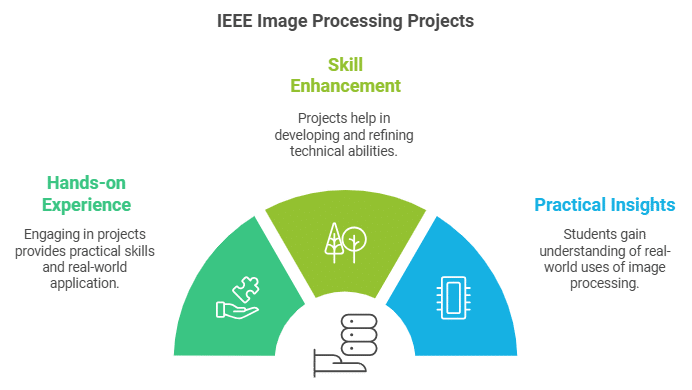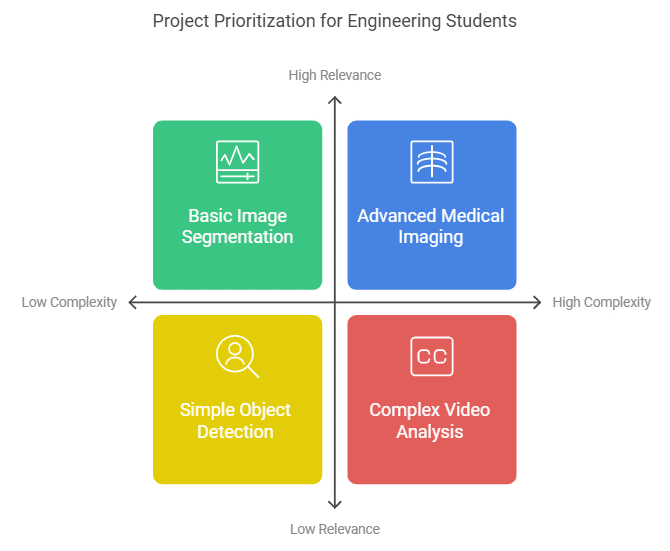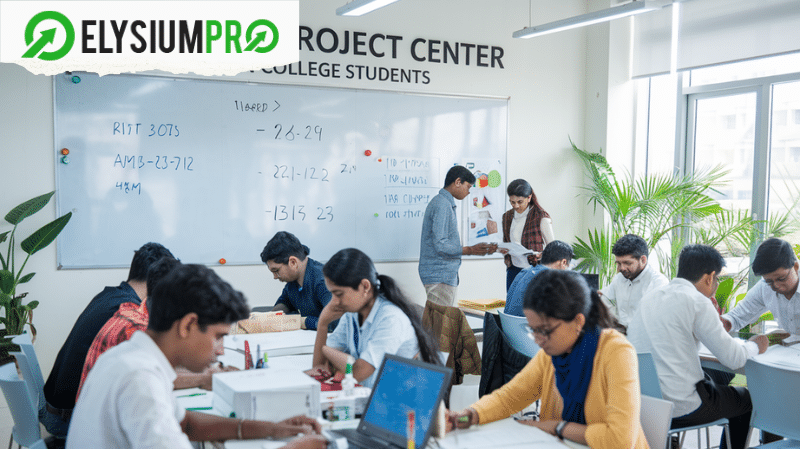
Exploring Cutting-Edge IEEE Networking Projects for Engineering Students
November 13, 2024
Top Final Year Web Development Projects for College Students
November 14, 2024Image processing is a fascinating field with applications spanning numerous industries, from healthcare to surveillance and entertainment. For engineering students, undertaking IEEE Image Processing Projects offers a unique opportunity to delve into real-world applications of digital image analysis, manipulation, and interpretation. By working on these projects, students can gain in-depth experience with various image processing techniques, algorithms, and software frameworks, ultimately paving the way for careers in fields like artificial intelligence, computer vision, and biomedical engineering.
Table of Contents
Image Recognition Using Deep Learning
Image recognition is a critical area in IEEE Image Processing Projects that involves training a system to identify and classify images based on specific characteristics. This project could involve using deep learning frameworks like TensorFlow or PyTorch to build a model that accurately recognizes objects, faces, or even medical conditions in images. By working on image recognition, students can explore neural networks and learn how to handle large datasets for training purposes.
For instance, an advanced image recognition project might involve building a system capable of identifying traffic signs to assist in autonomous driving technologies. Alternatively, students might develop a facial recognition system that could be applied in security or attendance systems. Through ElysiumPro support, students working on image recognition can access resources to effectively train and test their models, ensuring high accuracy and real-world applicability.
Digital Image Enhancement Techniques
Digital image enhancement aims to improve the quality of images, making this a valuable project within the scope of IEEE Image Processing Projects. Enhancement techniques include noise reduction, contrast adjustment, and edge sharpening. These methods can significantly improve images that are otherwise low in quality due to poor lighting, motion blur, or other factors.
In a typical image enhancement project, students may work with filters and algorithms to clean up images for various applications, such as medical imaging, where clear visuals are critical for accurate diagnoses. They may also delve into histogram equalization or frequency domain techniques to enhance features in an image. This type of project offers students a comprehensive understanding of signal processing and software tools like MATLAB and OpenCV, providing them with a robust foundation in image processing fundamentals.
Video Processing for Real-Time Surveillance Systems
Real-time video processing is another prominent topic in IEEE Image Processing Projects. Surveillance systems rely heavily on video processing to analyze live feeds and detect potential threats or anomalies. Students can work on developing a system that processes video data in real-time, applying filters and object detection algorithms to identify unusual activity.
A typical video processing project might involve building a motion detection system that triggers alerts upon detecting unauthorized movements in restricted areas. Alternatively, students could create a face detection tool that scans through video feeds and identifies individuals for security purposes. These projects are excellent for students interested in careers in security, AI, or computer vision, as they combine image processing with practical applications in surveillance technology.
Object Detection in Medical Imaging
Object detection within medical imaging is a highly impactful area within IEEE Image Processing Projects, particularly for students interested in healthcare applications. This project involves developing algorithms that can detect and classify anomalies in medical images, such as tumors in MRI or CT scans. By working on this project, students gain experience in applying AI to critical fields, where precision and accuracy are paramount.
Medical image analysis projects require an understanding of image segmentation, a process that divides an image into different regions based on color, texture, or intensity. Students can explore convolutional neural networks (CNNs) to improve detection accuracy, making this project both technically challenging and professionally rewarding. ElysiumPro provides the resources and guidance needed for students to work on healthcare-oriented image processing projects, preparing them for roles in biomedical engineering and AI-assisted diagnostics.
Image Compression Techniques for Efficient Data Transmission
Image compression is essential for efficient storage and transmission of large image files, making it a popular choice for IEEE Image Processing Projects. Students can develop compression algorithms that reduce file size while maintaining image quality, a skill highly valuable in fields like telecommunications and digital media.

A common approach in image compression projects involves using Discrete Cosine Transform (DCT) or Discrete Wavelet Transform (DWT) algorithms, which help reduce redundancy in image data. This type of project allows students to learn about trade-offs between compression rates and image quality, as well as gain familiarity with tools like MATLAB. Projects in image compression provide insights into data handling, making students better prepared for careers in networking, multimedia processing, and telecommunications.
Augmented Reality in Image Processing
Augmented Reality (AR) combines image processing with computer graphics to create interactive and immersive experiences. An AR-based project within IEEE Image Processing Projects might involve overlaying digital content onto real-world environments, an innovation frequently used in education, retail, and gaming.
For instance, students can develop an AR application that superimposes virtual objects onto live camera feeds. This could be applied in various scenarios, such as interactive product displays in retail or educational AR apps for visual learning. Working on AR-based image processing provides students with experience in a cutting-edge technology that is rapidly growing in popularity, equipping them with the skills needed for roles in tech innovation and digital content creation.
Optical Character Recognition (OCR) for Text Extraction
Optical Character Recognition (OCR) is a method used to convert printed or handwritten text into digital data, an essential task in data digitization. Within IEEE Image Processing Projects, an OCR project could involve developing an algorithm that accurately identifies and translates characters from scanned documents or images into editable text formats.
In an OCR project, students may work with character recognition techniques and delve into training models on diverse datasets to improve accuracy. This project has practical applications in fields like document management, data entry automation, and assistive technology for visually impaired users. By pursuing OCR-based projects, students can acquire valuable expertise in text recognition, machine learning, and software development.
Edge Detection for Industrial Inspection Systems
Edge detection is a technique in IEEE Image Processing Projects used to identify boundaries within images, making it valuable in industrial inspection and quality control systems. A project on edge detection might involve developing a system that analyzes images of manufactured goods to ensure they meet quality standards.
In this context, students could work with algorithms like Sobel or Canny edge detectors to identify imperfections in objects on production lines. Edge detection projects allow students to apply image processing in practical, industry-oriented scenarios, providing them with experience in automation and machine vision applications.
Image Restoration for Historical Data Preservation
Image restoration is a specialized area in IEEE Image Processing Projects focused on repairing degraded images. Students working on image restoration can create algorithms to reconstruct images that have been damaged by noise, blur, or pixelation. This project is ideal for those interested in fields like archival science, media preservation, and digital forensics.
Students can experiment with deblurring techniques and noise reduction algorithms to restore image quality. This project is an excellent way for students to delve into the technical aspects of image processing while contributing to preserving historical and cultural data.
Gesture Recognition for Human-Computer Interaction
Gesture recognition enables computers to interpret human gestures, making it a key technology in human-computer interaction. In IEEE Image Processing Projects, students can work on gesture recognition systems that respond to hand or body movements, a project relevant in fields like robotics, gaming, and assistive technology.
Gesture recognition projects might involve building a hand-tracking system that translates gestures into commands, allowing users to interact with machines more intuitively. This type of project provides students with experience in real-time image processing, machine learning, and interactive systems, all of which are valuable for future roles in tech development and automation.
Popular IEEE Image Processing Project Categories and Applications
| Project Category | Description | Applications |
|---|---|---|
| Image Segmentation | Divides an image into distinct regions to simplify analysis. | Medical imaging, object tracking, satellite imagery |
| Feature Extraction | Identifies unique patterns or features within images for further classification. | Face recognition, fingerprint identification, image categorization |
| Morphological Image Processing | Uses mathematical operations to process image structures, especially shapes and boundaries. | Industrial inspection, biological imaging, computer vision |
| Motion Analysis | Analyzes movement within video frames to detect and interpret motion patterns. | Video surveillance, sports analytics, autonomous vehicles |
| Image Fusion | Combines multiple images into a single, enhanced image to improve clarity or provide more detail. | Remote sensing, medical diagnostics, military applications |
Image Segmentation for Targeted Applications
Image segmentation plays a foundational role in IEEE Image Processing Projects by dividing images into segments or regions for easier analysis. This technique is often used in complex fields such as medical diagnostics, where it helps to delineate areas within MRI or CT scans, aiding physicians in identifying and analyzing tumors or lesions more accurately. For students, working on segmentation-based IEEE Image Processing Projects can offer a deep understanding of how algorithms, such as k-means clustering and thresholding, function to isolate and interpret specific areas within an image. Engaging with segmentation also prepares students for roles in data analysis, autonomous systems, and remote sensing, where precision and accuracy are paramount.

Feature Extraction in Image Classification
Feature extraction is another crucial topic in IEEE Image Processing Projects that focuses on identifying and extracting specific patterns or features within images for classification. Students might develop an image classification system that can differentiate between various objects based on their unique characteristics, such as shapes, colors, or textures. For instance, in face recognition applications, feature extraction can identify distinct facial landmarks to classify or authenticate individuals. By mastering feature extraction techniques, students build essential skills in machine learning and pattern recognition, making them well-suited for roles in data science, artificial intelligence, and computer vision.
Motion Analysis and Tracking in Video Processing
Motion analysis is an advanced area within IEEE Image Processing Projects that focuses on detecting and interpreting movement within video sequences. This type of project is particularly relevant for applications such as autonomous vehicle navigation, sports analytics, and surveillance systems. By analyzing consecutive frames in a video, students can create algorithms that track objects, measure velocity, and even predict future movements. Working on motion analysis IEEE Image Processing Projects equips students with knowledge in real-time data processing and predictive analytics, which are highly valuable in the fast-growing fields of robotics, smart city technology, and automated systems.
Each of these project areas offers engineering students an opportunity to develop specialized skills and engage in hands-on learning, setting them up for rewarding careers in image processing and related fields. ElysiumPro provides the essential resources and mentorship to guide students through these complex but highly educational IEEE Image Processing Projects.
FAQ
- What are some popular IEEE image processing project ideas? ElysiumPro offers a wide range of IEEE image processing projects, including image recognition, video processing, and gesture recognition systems.
- How can I start an IEEE image processing project for my final year? At ElysiumPro, we provide resources and expert guidance for starting IEEE image processing projects, covering everything from project selection to implementation.
- What tools are recommended for IEEE image processing projects? ElysiumPro recommends tools like MATLAB, OpenCV, and TensorFlow for IEEE image processing projects, providing a comprehensive software foundation for students.
- Are there any IEEE projects focused on video processing? Yes, ElysiumPro offers IEEE video processing projects that cover real-time surveillance, object detection, and motion analysis for various applications.
- How does image enhancement benefit my IEEE project? Image enhancement is crucial in IEEE projects, as it improves data clarity and accuracy, which is essential for tasks such as medical imaging and industrial inspection. ElysiumPro supports these IEEE Image Processing Projects with quality resources.
Related Blogs:
Python Projects | Internet of things projects | Networking Projects | Web Development Projects | Amazing Final year projects | Software Engineering Projects | Machine Learning Projects | Cloud Computing Projects | MatLab Projects | Engineering Projects | Java Projects | Wireless Networking Projects | Power Electronics Projects


